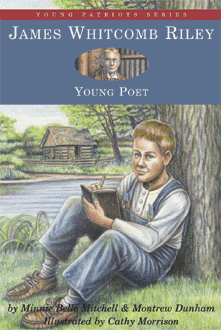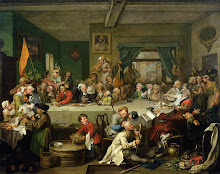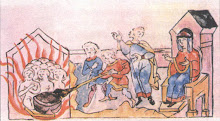
In 1877, a struggling young Kokomo, Indiana poet named James Whitcomb Riley stated to friends that his lack of literary success was due to the fact that he did not have a "name." Critics judged a work not simply by its merits, he believed, but by the reputation of its author. To prove his point, he wrote a poem he called "Leonainie," in what he fancied was the style of Edgar Allan Poe. A friend of Riley's, the editor of a local paper, was enlisted in the hoax, and he cheerfully published the doggerel under the arresting headline:
POSTHUMOUS POETRY
A HITHERTO UNPUBLISHED POEM OF
THE LAMENTED EDGAR ALLAN POE--
WRITTEN ON THE FLY-LEAF OF AN
OLD BOOK NOW IN THE POSSESSION OF
A GENTLEMAN OF THIS CITY
The accompanying article went on to explain that the editor, while recently visiting said "gentleman of this city," was shown a book with a poem, signed "EAP," written on a blank page. The "gentleman" explained that he had been given the book by his grandfather, who many years previously had kept an inn in Chesterfield, Virginia, near Richmond. One night, a young man clearly the worse for drink arrived asking for a room. The next morning, when the grandfather came to the room to summon the man to breakfast, he found his guest had disappeared, leaving behind only this book.
This story--which is actually one of the more plausible-sounding newspaper stories regarding Poe--caused a nation-wide sensation. Although the poem had its naysayers--the "Boston Transcript" commented that "if Poe really did write it, it is consolation to think he is dead"--most were only too eager to embrace any "new" Poe material, even if it meant accepting that the man who wrote "The Raven" and "Annabel Lee" also penned lines like:
This story--which is actually one of the more plausible-sounding newspaper stories regarding Poe--caused a nation-wide sensation. Although the poem had its naysayers--the "Boston Transcript" commented that "if Poe really did write it, it is consolation to think he is dead"--most were only too eager to embrace any "new" Poe material, even if it meant accepting that the man who wrote "The Raven" and "Annabel Lee" also penned lines like:
"'Leonainie!' angels missed her--
Baby angels--they
Who behind the stars had kissed her
E'er she came away;
And their little, wandering faces
Drooped o'er Heaven's hiding places
Whiter than the lily-vases
On the Sabbath day."
When asked to produce the manuscript of this previously unknown masterpiece, Riley enlisted an artist friend, who, using a facsimile of a few lines of Poe's handwriting as a model, forged a copy of "Leonainie" on the fly-leaf of an old Latin dictionary. For many people, the results were conclusive evidence the poem was genuine. Poe scholar Edmund Clarence Stedman stated that he had studied many Poe manuscripts--some real, some forgeries--and the poem found in this old book was as genuine an example of Poe's writing as he had ever seen. The highly respected literary critics William Cullen Bryant and Alfred Russel Wallace also unhesitatingly endorsed the poem's authenticity. Just when it looked like there would be a new addition to the accepted body of Poe's work, someone ratted. An informant--it is not clear who--told the true history of the manuscript to the editor of a rival Kokomo paper. When the hoax was finally made public, Riley--who, to do him justice, had become increasingly uncomfortable with the unexpected success of his little prank--confessed all. Even then, there were some who refused to believe him. For years afterward, Alfred Wallace continued to insist that the manuscript just had to be Poe's work.
The lesson to be learned from the "Leonainie" debacle is, I fear, lost on many Poe researchers. In their understandable eagerness to expand the relatively scanty body of information we have about the author, far too many are far too ready to latch onto any "new" Poe letters or manuscripts, no matter how questionable they may be. And I may say that, in this regard, I an looking with a particularly jaundiced eye upon this poem. It is a genuine mystery to me why "To Miss Louise Olivia Hunter" has been universally accepted as an authentic Poe MS. The previously unknown poem did not surface until 1932, with no information given about where it had been hiding for the previous nine decades. Louise Hunter was a real person--an obscure young poetess whose mediocre verse appeared occasionally in the magazines of the era--but aside from the fact that Poe was one of the judges for an 1845 student literary competition Miss Hunter won, there is nothing linking their names. When this poem's existence was first made known, a relative of Hunter's publicly expressed her astonishment. She said that Miss Hunter was fond of talking of the literary celebrities she had known (including Frances S. Osgood,) and she never once claimed to have even been introduced to Poe, much less that he had composed a poem in her honor.
Questions have been raised about the date this poem was allegedly composed. The MS.--which is unsigned--has the date "February 14" written in the same handwriting as the poem. Another hand had, in pencil, written the year "1847." This dating was accepted by Mabbott, but others argue for an 1846 date, pointing out that Valentine's Day, 1847, was only two weeks after the death of Virginia Poe. They find it unlikely that Poe--buried in his remote cottage at Fordham, ill, and grieving--would be wasting his energies writing puerile poems to young ladies he must have scarcely, if at all, known. This uncertainty in dating only adds to the poem's untrustworthiness. In short, there is no reason in the world--not even a signature--to identify this manuscript poem with Poe. I have no idea how anyone ever did so in the first place.
The lesson to be learned from the "Leonainie" debacle is, I fear, lost on many Poe researchers. In their understandable eagerness to expand the relatively scanty body of information we have about the author, far too many are far too ready to latch onto any "new" Poe letters or manuscripts, no matter how questionable they may be. And I may say that, in this regard, I an looking with a particularly jaundiced eye upon this poem. It is a genuine mystery to me why "To Miss Louise Olivia Hunter" has been universally accepted as an authentic Poe MS. The previously unknown poem did not surface until 1932, with no information given about where it had been hiding for the previous nine decades. Louise Hunter was a real person--an obscure young poetess whose mediocre verse appeared occasionally in the magazines of the era--but aside from the fact that Poe was one of the judges for an 1845 student literary competition Miss Hunter won, there is nothing linking their names. When this poem's existence was first made known, a relative of Hunter's publicly expressed her astonishment. She said that Miss Hunter was fond of talking of the literary celebrities she had known (including Frances S. Osgood,) and she never once claimed to have even been introduced to Poe, much less that he had composed a poem in her honor.
Questions have been raised about the date this poem was allegedly composed. The MS.--which is unsigned--has the date "February 14" written in the same handwriting as the poem. Another hand had, in pencil, written the year "1847." This dating was accepted by Mabbott, but others argue for an 1846 date, pointing out that Valentine's Day, 1847, was only two weeks after the death of Virginia Poe. They find it unlikely that Poe--buried in his remote cottage at Fordham, ill, and grieving--would be wasting his energies writing puerile poems to young ladies he must have scarcely, if at all, known. This uncertainty in dating only adds to the poem's untrustworthiness. In short, there is no reason in the world--not even a signature--to identify this manuscript poem with Poe. I have no idea how anyone ever did so in the first place.
 The poem itself argues conclusively against any attempts to claim it as Poe's handiwork. It is certainly true that some of his poems were far weaker than others. However, I dare anyone to read "To Miss Louise Olivia Hunter" objectively and then accept that, even on the worst day of his life, Poe could be capable of composing such ridiculous drivel. And preserving it for posterity, yet. He'd cut off his own right hand first. The author of this poem--whoever he or she might have been--made "Leonainie" look positively sublime.
The poem itself argues conclusively against any attempts to claim it as Poe's handiwork. It is certainly true that some of his poems were far weaker than others. However, I dare anyone to read "To Miss Louise Olivia Hunter" objectively and then accept that, even on the worst day of his life, Poe could be capable of composing such ridiculous drivel. And preserving it for posterity, yet. He'd cut off his own right hand first. The author of this poem--whoever he or she might have been--made "Leonainie" look positively sublime.Long ago, I came to the conclusion that Poe scholars are, in general, a singularly credulous lot, but in their immediate, unskeptical readiness to include this absurd little poem in the Poe canon, they truly outdid themselves.
Update 2/2012: Jeffrey A. Savoye of the Edgar Allan Poe Society of Baltimore recently alerted me to the fact that a few months ago a researcher named Ton Fafianie has identified "To Miss Louise Olivia Hunter" as the work of William Gilmore Simms, although scholars still presume that it was Poe--in a moment, I assume, of greatly lapsed taste--who copied the poem as a Valentine for Miss Hunter. Mr. Fafianie has prepared an article for publication on the topic. When it comes out, I shall do my best to hunt down a copy and post further information about these contentious little verses.
Update 5/2012: I was recently able to read Mr. Fafianie's painstaking and highly interesting research on the poem. ("Poe's Purloined Poem," "The Simms Review," Summer/Winter 2011.) He proves conclusively that the "Hunter" poem was cribbed from Simms' work, which was first published in the "American Monthly Magazine" of July 1, 1834, (where it was called simply, "Song,") and later in the January 1840 "Southern Literary Messenger" under the title, "There are Dreams of Bowers." However, as the "Hunter" manuscript's provenance is unknown (we do not even know how A. S. W. Rosenbach, the 1932 "discoverer" of the poem, acquired the item,) and it is still a complete mystery how or why Poe would have made this copy at all, (Mr. Fafianie's suggestion that Caroline Kirkland instigated Poe to create this second-hand Valentine is too tenuous to be convincing,) I am still uncertain we are dealing with any sort of genuine Poe document.
Yes, I know. Like the world cares what I think.
P.S. Mr. Fafianie noted that the final version of Simms' poem (the version borrowed for "Hunter") was published in May of 1846, which suggests an 1847 date for this MS. However, this just complicates matters further. If Poe truly did write out this poem, (presumably for one of Anne Lynch's Valentine parties, where everyone in her circle was called upon to write odes to each other) it seems only logical that he would have done so in the earlier year. Even leaving aside the improbability that two weeks after Virginia's death, he would be dealing with such trivialities, by 1847, Poe was persona non grata among the Lynch mob, and was no longer participating in such gatherings. If Mr. Savoye's theory--that Miss Hunter's mentor Frances Osgood had commissioned Poe to write a Valentine for her young friend--is correct, that would also indicate an 1846 dating. By February 1847, Mrs. Osgood had left New York for Philadelphia, and her own reminiscences indicate that she had no contact with Poe after early 1846. As I said earlier, the difficulty with assigning a plausible date to this poem just adds to the mystery.















